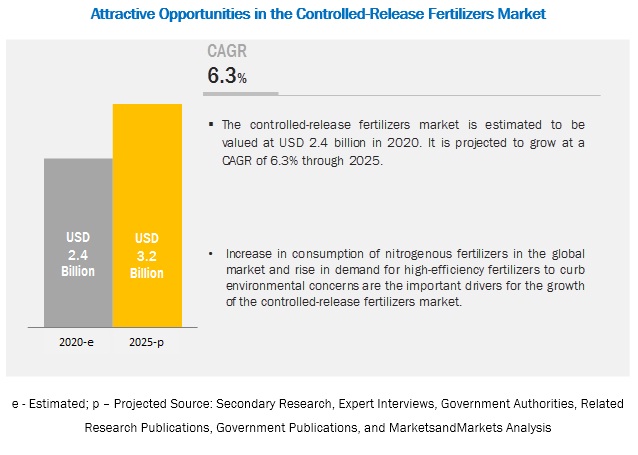Factors Driving the Controlled-release Fertilizers Market
The global controlled-release fertilizers market is estimated at USD 2.4 billion in 2020 and is projected to reach USD 3.2 billion by 2025. The controlled-release fertilizers market is projected to grow at a rate of 6.3% during the forecast period. Factors driving the market include an increase in demand for highly efficient fertilizers, favorable government regulations, a rise in demand for high-value crops, and an increase in the number of investments from key players in this market. The growing environmental concerns associated with nutrient loss through soil leaching and runoffs from fields on the using excess conventional fertilizers are effectively addressed by these fertilizers.

Download PDF Brochure:
https://www.marketsandmarkets.com/pdfdownloadNew.asp?id=136099624
The agricultural segment is projected to be the faster-growing segment in the controlled-release fertilizers market during the forecast period.
As the market demand shifts towards the usage from NPK fertilizers to controlled-release fertilizers in the developing economies, there is an increase in demand for controlled-release fertilizers. The manufacturers are continuing research efforts to develop cheaper and better coatings/materials to reduce the overall cost and encourage the adoption of this technology.
The slow-release segment is projected to record the fastest growth during the forecast period.
The slow-release segment is projected to be the fastest-growing segment. Urea-formaldehyde fertilizers are most effective in high temperatures and are hence used in regions with warm climatic conditions such as the Asia Pacific Mediterranean region in Europe and the southwestern region of the US.
The fertigation segment is projected to record the fastest growth during the forecast period.
The demand for controlled-release fertigation has been mostly concentrated in high-value crops such as fiber crops (jute and cotton), plantation crops (cocoa, pepper, and rubber), and ornamentals, as they require the application of fertilizers to improve the crop quality and yield.
Asia Pacific is projected to witness significant growth during the forecast period
Asia Pacific accounted for the largest share. The region is projected to grow at the highest CAGR of 6.2% & 6.0% in terms of value & volume, respectively, during the forecast period. The increasing growth of high-value crops and raising awareness among farmers about the environmental benefits of controlled-release fertilizers are expected to provide more scope for market expansion. The government policies adopted by Asia Pacific countries and the large subsidies, in certain countries up to 100% for marginal farmers, provided on fertilizers are the major factors triggering the growth of this market in the region. R&D investments in the development of coated fertilizers and the installation of new production capacities by key players are expected to boost the market in the next five years.
Speak to Analyst:
https://www.marketsandmarkets.com/pdfdownloadNew.asp?id=136099624
Key companies in the controlled-release fertilizers market are Nutrien Ltd. (Canada), Yara International ASA (Norway), ICL (Israel), ScottsMiracle-Gro (US), Koch Industries (US), Helena Chemical (US), Kingenta (China), SQM (Chile), Haifa Chemicals (Israel), JCAM AGRI. (Japan), COMPO EXPERT (Germany), Nufarm Ltd. (Australia), The Andersons Inc. (US), Van Iperen International (Netherlands), Mosaic Company (US), OCI Nitrogen (Netherlands), AgroLiquid (US), DeltaChem (Germany), SK Specialties (Malaysia), and Pursell Agri-Tech (US). New product launches, expansions, agreements, and acquisitions have been the areas of focus of these manufacturers to gain better penetration in the developing markets of Asia Pacific and South America.
Recent Developments:
- In September 2019, Nutrien, Ltd. (Canada) acquired Ruralco Holdings Limited (Ruralco) in Australia. Through this acquisition, Nutrien would provide significant benefits to its stakeholders as well as enhance the delivery of its products and services to Australian farmers.
- In August 2019, Yara International ASA (Norway) and Nel Hydrogen Electrolyser, a division of Nel ASA (Norway), entered into a collaboration agreement for low-carbon-footprint fertilizer production at Yara’s existing plant in Porsgrunn, Norway. This project was supported by the Research Council of Norway, Innovation Norway, and Enova through the PILOT-E program.
- In March 2019, Yara International ASA (Norway) launched Yaralix, a tool for precision farming, allowing the farmers to measure crop nitrogen requirements using their smartphones. The system consisted of a free-to-download application that was designed to handle the smartphone camera to determine nitrogen requirements for different crops in the early growth stages.